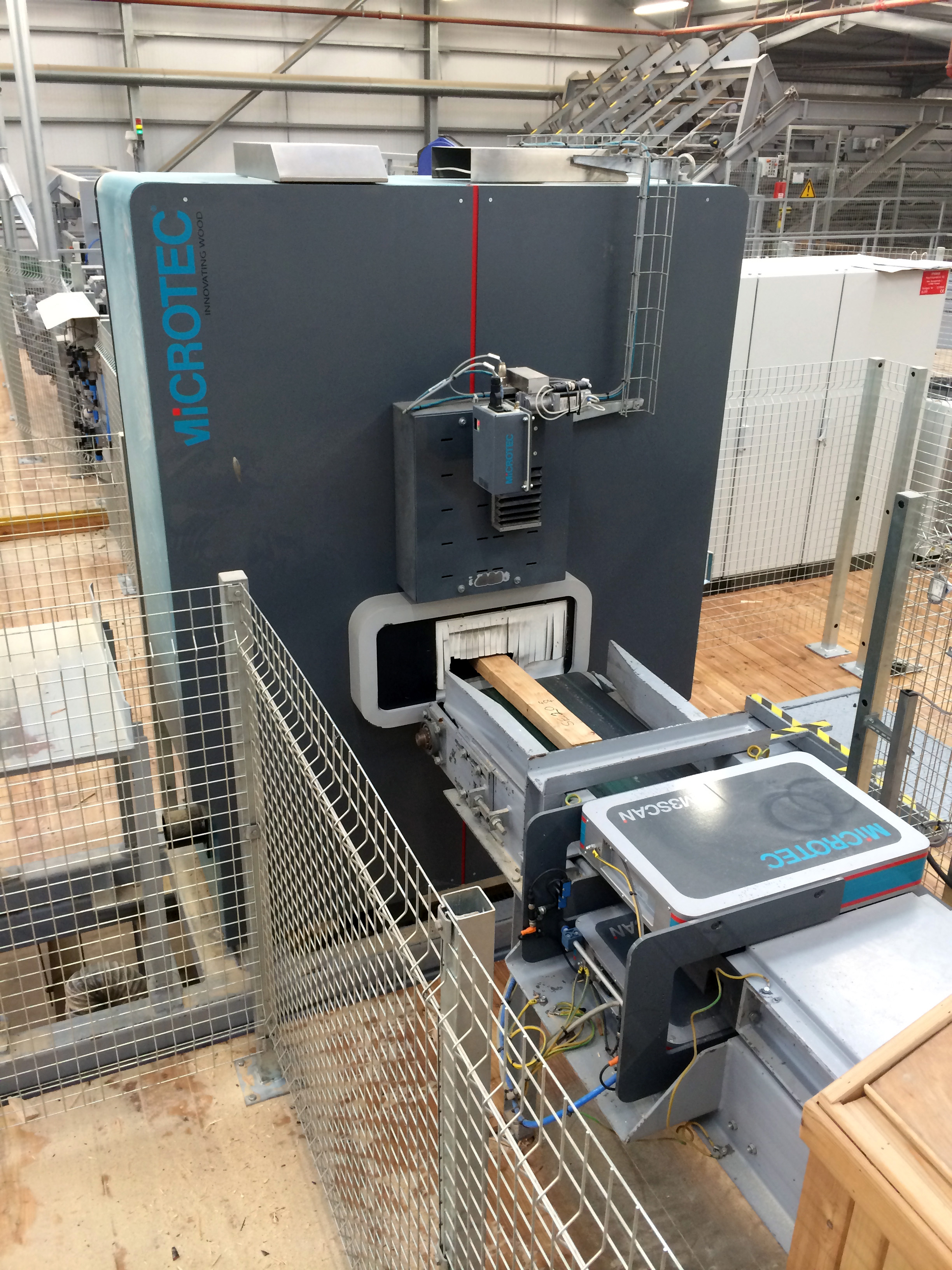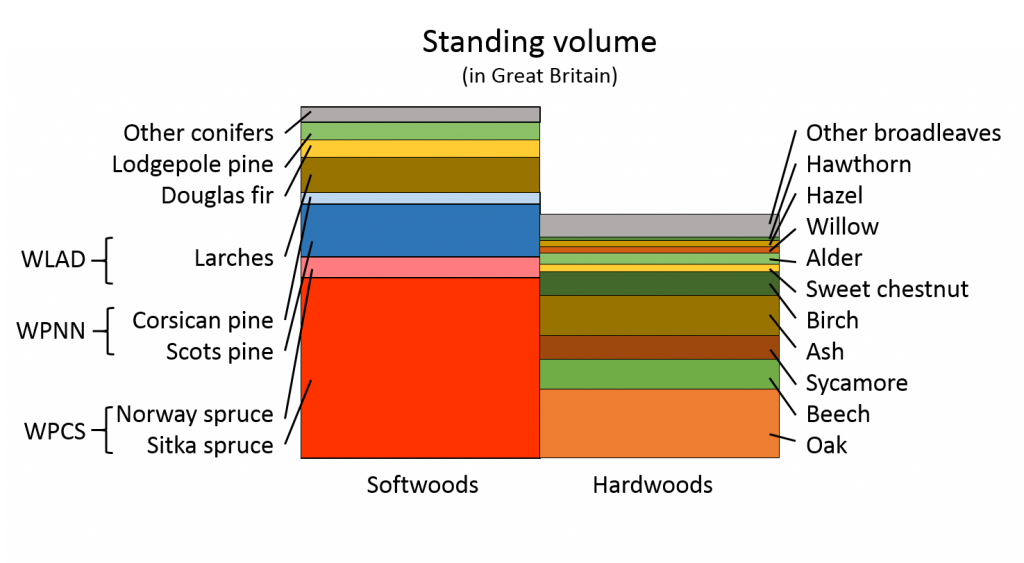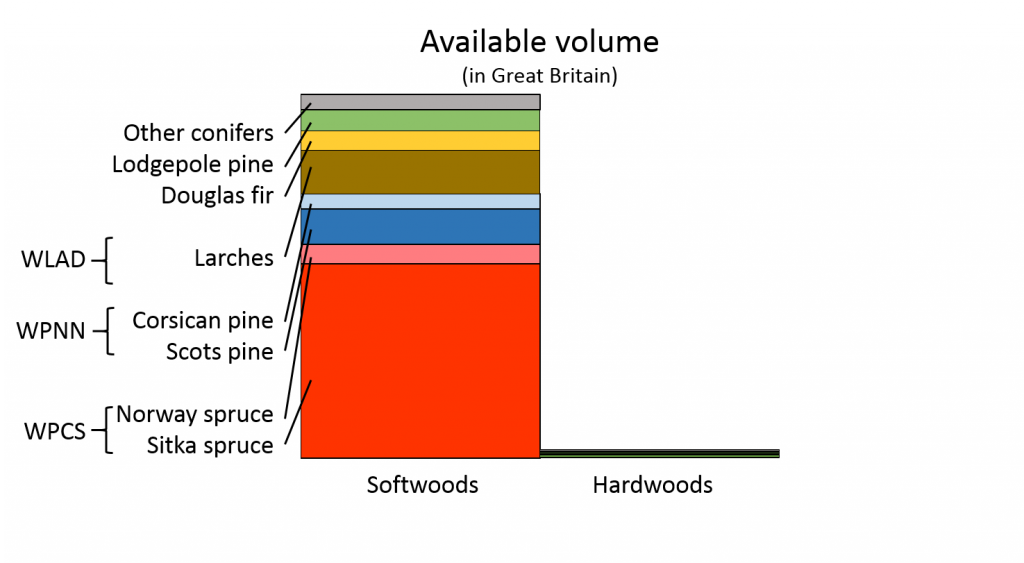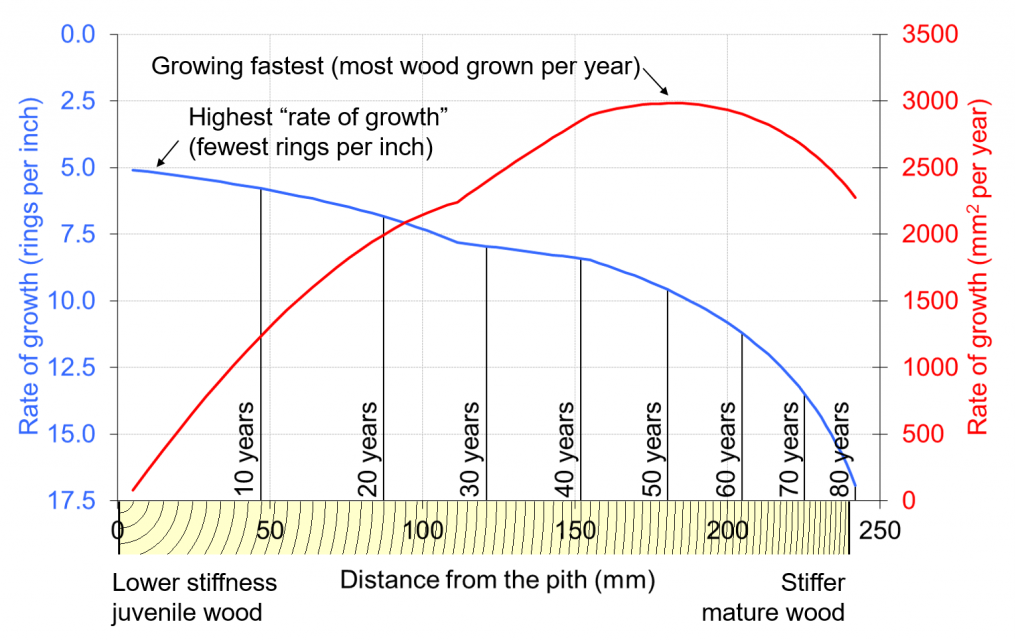
For a more up-to-date post on properties see Grade in Britain revisited.
Introduction
We looked at British spruce in a previous post. It is, for the main part, Sitka spruce (Picea sitchensis) which is the UK’s main commercial species. Indeed, a little over one quarter of the total forest area in Great Britain is Sitka.
Concerns about the resilience of the forest to pests, diseases and climate change mean that we are increasingly looking at other species that we can grow in the UK, and what products they may be useful for. One obvious question is: how do these species compare to Sitka spruce, in suitability for structural timber?
This post forms the background for a presentation at The Institute of Chartered Foresters annual conference on 27-28 April. Dan Ridley-Ellis will be speaking in session 4 “Processing for value and profit” with a talk entitled “Making the grade and maximising the opportunities” #ICFTimberCon
Important: this information is for explanation only – it is not a substitute for reading the relevant codes, standards and other official documents.
Edit January 2019 – you can now read updated information about the grading of spruce, larch and Douglas-fir on the “Grade in Britain revisited” blog post.
What species do we have, and what species should we think more about?
Two recent publications from Forestry Commission are very useful for looking at what species we currently have in the GB forest, and what volumes of timber are likely to be available in the future.
National Forest Inventory: 50-year forecast of softwood availability
National Forest Inventory: 50-year forecast of hardwood availability
The information on volume is summarised below (see tables 1 and 2, at the bottom of this page, for more detail). While there is a lot of standing volume of hardwood species, the available volume is very small compared to softwoods (although this can potentially increase eight-fold by 2045). The majority of the available timber volume available falls into the EN14081-1 species combinations: British spruce (WPCS), British pine (WPNN) and Larch (WLAD) – and most of this is Sitka spruce.



We have already worked on these softwood species (species codes as in EN13556:2003):
- Sitka spruce (Picea sitchensis) (PCST)
- Norway spruce (Picea abies) (PCAB)
- Hybrid larch (aka Dunkeld larch) (Larix x eurolepis) (LAER)
- Japanese larch (Larix kaempferi) (LAKM)
- European larch (Larix decidua) (LADC)
- Douglas fir (Pseudotsuga menziesii) (PSMN)
- Scots pine (Pinus sylvestris) (PNSY)
The group “other conifers” covers a number of species that have potential for greater planting. However, because there is not a lot of these species currently growing in the UK it is rather harder to evaluate their properties. These are the species we have worked on (enough to have a reasonable idea of the properties):
- Noble fir (Abies procera) (ABPR)
- Western hemlock (Tsuga heterophylla) (TSHT)
- Western red cedar (Thuja plicata) (THPL)
These are the species currently on our list to investigate next:
- Serbian spruce (Picea omorika)
- Pacific silver fir (aka amabilis fir) (Abies amabilis) (ABAM)
- Japanese incense cedar (aka sugi / Japanese red cedar) (Cryptomeria Japonica) (CYJP)
- Grand fir (Abies grandis) (ABGR)
- European silver fir (Abies alba) (ABAL)
(Serbian spruce is not listed in EN13556:2003, so has no four letter code. Logically, if it had one, it would be PCOM)
We have not looked at hardwoods so far, but these species are on our list to investigate next:
- Sycamore (Acer pseudoplatanus) (ACPS) – which has potential for 8 times increase in available volume by 2045
- Birch (Betula pendula/pubescens) (BTXX) – which has potential for 13 times increase in available volume by 2045
So what are the properties like?
Some of the factors that affect timber properties are familiar to anyone who has worked with wood. They include density, knots, and character of grain. It is easy to imagine that density equates to the amount of strength-giving material. Similarly, it is easy to imagine that wide growth rings equate to fast growth and, as a result, low density. However, like many things in life, the truth is a bit more complicated than what is immediately obvious. Most notably, density does not tell the whole picture, as it depends how the strength-giving material is arranged and composed.
It is often said that UK plantations grow too quickly, compared to the colder forests of Scandinavia, and that the result is low density timber. Years of work at Edinburgh Napier University on the UK’s main commercial species, Sitka spruce (Picea sitchensis), has categorically shown that density is, in fact, the least limiting property (e.g. Moore et al 2013 and Moore 2011). It is true that Sitka reaches saw log size rather quickly, which is an advantage in a country prone to damaging storms. The downside is that a high proportion of a short rotation conifer log is made up of juvenile wood, which is generally less stiff. Some of what we associate as rate of growth is actually just the annual rings getting narrower with increasing diameter. Timbers with apparent slower rate of growth may just be from the stiffer mature wood, further from the pith, when the tree was actually growing, in total volume terms, faster. See Moore (2011) for information about how wood properties vary from pith to bark).

The properties of structural timber can be conveniently compared using the system of C classes in the European Standard EN338. Strength classes are defined by three main properties: bending strength, bending stiffness and density, and are named according to the strength requirement. The class that timber can be assigned to in grading is governed by whichever of the three properties is limiting. We have seen that UK-grown Sitka spruce fits to C16 by its stiffness, having the strength required of C18 and density of C20. These are grades for near 100% yield (for simplicity, I shall refer to this here as the ‘basic grade’) and there are higher grades within the resource as a whole. Indeed it is possible, with existing grading technology, to grade small yields of C27, and there are some stands that could, with compatible technology and standards, be graded entirely to C24 (See Moore et al 2013).
Note: It is only possible to grade using a particular grade combination of, typically, one, two or three strength classes and yields depend on what combination of grades are. A higher grade can be obtained at the cost of reducing the yield (i.e. having a higher reject rate). See our previous post on how grading actually works.
Regional variation of properties means the situation for individual mills varies. This is because stiffness is evaluated by mean value, and small variations in mean stiffness from site-to-site require relatively larger shifts in the grading threshold than would grade-limiting shifts in strength and density, which are evaluated by lower 5th percentile. For machine control grading the thresholds are set at a level that is deemed to work for all mills within the growth area (the regions in which the settings are valid). This means that mills in regions of good quality timber cannot necessarily take full advantage and gain higher yields of higher grades – unless they operate output control grading.
Even with fixed settings, yields will vary from mill to mill within the growth area, depending on the quality of the timber it is processing at that time. When the yields are normally close to 100% this variation does not have much impact in absolute terms (although the percentage change in reject rates can be large), but when yields of a grade are normally much less (say, 30%) the differences can be considerable.
We recently also carried out a large study to establish machine grading settings for UK grown larch (Larix decidua/x eurolepis/kaempferi). As with Sitka, the main limiting factor is the stiffness, although strength is also close to limiting. The basic grade is C22, but it achieves the density required for C35. Small yields of C35 could indeed be graded but it is probably better to go for C27 with a yield of around 30-40% and the majority of what remains grading to C16. While this is not quite in the same league as European larch from the Alps, or Siberian larch from Russia (both basic grade C24) it is a pretty good showing for UK timber. The reason we undertook the work on larch was, of course, Phytophthora ramorum.
We have done some work on Scots pine (Pinus sylvestris) (PNSY) (e.g. Macdonald et al 2010), but it is, of course, already a commercially important timber so a lot is already known and we have a reasonably good idea of its properties from existing grading machine settings. The basic grade is C18 to C20.
Tom Drewett recently completed his PhD thesis on UK grown Douglas fir (Pseudotsuga menziesii). Our data is less extensive, and grading indications more tentative, but it looks as though this is also stiffness limited with, perhaps, a basic grade of C18 or C20. As with larch, strength is close to limiting and density is not critical (meeting the C27 requirement).
PhD student David Gil-Moreno is close to finishing his study of noble fir (Abies procera), western hemlock (Tsuga heterophylla), Norway spruce (Picea abies) and western red cedar (Thuja plicata). With these minor species, a big challenge has been getting stands that are comparable to commercial Sitka stands, and the data that follows has been adjusted in an attempt to predict likely properties for a 45 year rotation. The number of samples is relatively small, and results must therefore be treated with caution.
Norway spruce is already processed and sold alongside Sitka spruce as ‘British spruce’. It has long been known that the properties are similar, but suspected that Norway is slightly better. This appears to be the case (basic grade C18, stiffness and strength limiting with density meeting C22). western hemlock and noble fir also appear similar to Sitka, although noble fir appears to be strength limited. Western red cedar is stiffness limited to a greater extent, but is probably still capable of producing high yields of C16.
More information about David’s study will be out soon, so watch this space.
Work is currently underway on other candidate species, and we now have Serbian spruce (Picea omorika), Pacific silver fir (Abies amabilis), Japanese incense cedar (Cryptomeria Japonica), grand fir (Abies grandis) and European silver fir (Abies alba) sawn into joist-dimension specimens for testing. The other species in our sights are sycamore (Acer pseudoplatanus) and birch (Betula pendula/pubescens).
What does this mean for strength grading?
The machine control settings that, at the current time, have been approved for UK grown timber are listed in Table 3 below. The ones coloured blue were developed by us.
The figures below are extracted from a presentation made in February 2016, and they indicate our best assessment of the species we currently have data on, as well as some existing visual grading assignments (in EN1912 and BSI document PD 6693). The fading line indicates the basic grade (or our estimate of it) to the highest grade likely to be possible (or our estimate of it). The highest grade would have very low yields.
[Edit April 2018: We have now done more work on Douglas fir and the we can move that to the “confident” category. The bottom end of C18 is about right shown below, but grades up to C40 can also be obtained! The reason for the large range is that strength limits the grading in this case – whereas for spruce and larch stiffness is usually the limit for the UK grown timber. Since stiffness is a mean property and strength is a fifth percentile it is easier to raise the strength by grading than it is the stiffness]


What about the rest? Well, we have to make a lot of assumptions based on limited data – and these are really just educated guesses (so treat them with caution):
- Serbian spruce (Picea omorika) : Probably not quite as good as Sitka spruce, but not far off
- Pacific silver fir (aka amabilis fir) (Abies amabilis) (ABAM) : Not enough information
- Japanese incense cedar (aka sugi / Japanese red cedar) (Cryptomeria Japonica) (CYJP) : Not enough information
- Grand fir (Abies grandis) (ABGR): Not enough information
- European silver fir (Abies alba) (ABAL) : Probably a bit better than Sitka spruce – basic grade could be C18 or C20
- Sycamore (Acer pseudoplatanus) (ACPS) : Potentially C18
- Birch (Betula pendula/pubescens) (BTXX) : Potentially C30…if a sawlog could actually be found
- Macedonian pine (Pinus peuce) : Most likely lacking adequate stiffness for construction, but has reasonable strength and density for some uses
- Maritime pine (Pinus pinaster) (PNPN) : Probably similar to Sitka spruce
As above, the four letter species codes are from EN13556:2003 (not all species are listed).
See the appendix of Ramsay and Macdonald (2013) for a brief outline of how we make educated guesses, and our previous post on EN338 for why we listed “softwood” grades for the hardwoods.
Footnotes
We gratefully acknowledge the assistance of funders and collaborators too numerous to list here, but particular thanks are extended to Forest Research, without whose help we would have very little. Thanks are also due to Elspeth Macdonald (of UHI) for spotting some errors on this page.
A shorter version of this article appears in “Forestry & Timber News” (Confor) April 2016 (text here)
Tables
Table 1: Volume statistics for softwoods in Great Britain
| Species code | Combination | ||||||
| Great Britain | Table A1 | Table A2 | Available | ||||
| stocked area (000 ha) |
standing volume (000m3 obs) |
volume (000m3 obs) | EN13556:2003 | EN14081-1:2016 | |||
| 2013-16 | |||||||
| All conifers | 1,307.5 | 354,748 | 16,487 | ||||
| Sitka spruce | 664.6 | 180,872 | 8,776 | Picea sitchensis | PCST | British spruce | WPCS |
| Norway spruce | 60.6 | 21,091 | 868 | Picea abies | PCAB | ||
| Scots pine | 218.2 | 52,725 | 1,594 | Pinus sylvestris | PNSY | British pine | WPNN |
| Corsican pine | 45.6 | 11,738 | 683 | Pinus nigra subsp. laricio | PNNL | ||
| Larches | 126.0 | 35,586 | 1,965 | Larix x eurolepis | LAER | Larch | WLAD |
| Larix kaempferi | LAKM | ||||||
| Larix decidua | LADC | ||||||
| Douglas fir | 45.6 | 16,907 | 898 | Pseudotsuga menziesii | PSMN | ||
| Lodgepole pine | 99.8 | 18,298 | 950 | Pinus contorta | PNCN | ||
| Other conifers | 39.6 | 15,390 | 690 | ||||
National Forest Inventory: 50-year forecast of softwood availability (Forestry Commission, April 2014)
(figures are as at 31 March 2012)
Table 2: Volume statistics for hardwoods in Great Britain
| Species code | |||||
| Great Britain | Table A1 | Table A2 | Available | ||
| stocked area (000 ha) |
standing volume (000m3 obs) |
volume (000m3 obs) | EN13556:2003 | ||
| 2013-16 | |||||
| All broadleaves | 1,336.6 | 245,098 | 372 | ||
| Oak | 219.1 | 69,434 | 56 | Quercus robur | QCXE |
| Quercus petraea | |||||
| Beech | 93.7 | 29,931 | 70 | Fagus sylvatica | FASY |
| Sycamore | 106.3 | 23,623 | 38 | Acer pseudoplatanus | ACPS |
| Ash | 157.0 | 40,341 | 35 | Fraxinus excelsior | FXEX |
| Birch | 235.5 | 23,223 | 50 | Betula pendula | BTXX |
| Betula pubescens | |||||
| Sweet chestnut | 28.9 | 7,996 | 9 | Castanea sativa | CTST |
| Alder | 57.6 | 11,025 | 6 | Alnus glutinosa | ALGL |
| Willow | 65.2 | 6,523 | 19 | Salix spp. | SAXX |
| Hazel | 86.8 | 6,458 | 7 | ||
| Hawthorn | 72.6 | 3,416 | 24 | ||
| Other broadleaves | 211.9 | 22,860 | 57 | ||
National Forest Inventory: 50-year forecast of hardwood availability (Forestry Commission, April 2014)
(figures are as at 31 March 2012)
Table 3: Current approved strength grading machine settings for UK grown timber
This table last updated 19/6/2018
| Machine name | Operation | Species |
| Brookhuis Micro-Electronics [& LuxScan] | ||
| MTG 920 [and ESCAN] | Longitudinal frequency | British spruce (WPCS), UK larch (WLAD), Douglas fir (PSMN) |
| MTG 960 [and ESCAN] | Longitudinal frequency & density (mass & volume) | British spruce (WPCS), UK larch (WLAD), Douglas fir (PSMN) |
| Dynalyse AB | ||
| Precigrader | Longitudinal frequency (microphones) & density (mass & volume) | British spruce (WPCS) |
| MPC | ||
| Computermatic | Bending | British spruce (WPCS), British larch (WLAD), British pine (WPNN) |
| Cook-Bolinder | Bending | British spruce (WPCS), British larch (WLAD), British pine (WPNN) |
| MiCROTEC | ||
| ViSCAN | Longitudinal frequency (laser vibrometer) | British spruce (WPCS), UK larch (WLAD), Douglas fir (PSMN) |
| ViSCAN-Compact | Longitudinal frequency (laser vibrometer) & density (mass & volume) | British spruce (WPCS), UK larch (WLAD), Douglas fir (PSMN) |
| ViSCAN-Plus | Longitudinal frequency (laser vibrometer) & density (X-ray) | British spruce (WPCS), UK larch (WLAD), Douglas fir (PSMN) |
| ViSCAN-portable | Longitudinal frequency (laser vibrometer) &, optional, density (mass & volume) | British spruce (WPCS), UK larch (WLAD), Douglas fir (PSMN) |
| GOLDENEYE GE702 | X-ray (knots & density) | British spruce (WPCS), UK larch (WLAD), Douglas fir (PSMN) |
| GOLDENEYE GE706 | X-ray (knots & density) & longitudinal frequency (laser vibrometer) | British spruce (WPCS), UK larch (WLAD), Douglas fir (PSMN) |
The ones coloured blue were developed by Edinburgh Napier University.
(Contact the grading machine manufacturers if you want more information on the settings)

Great post – just what I was looking regarding strength ratings!